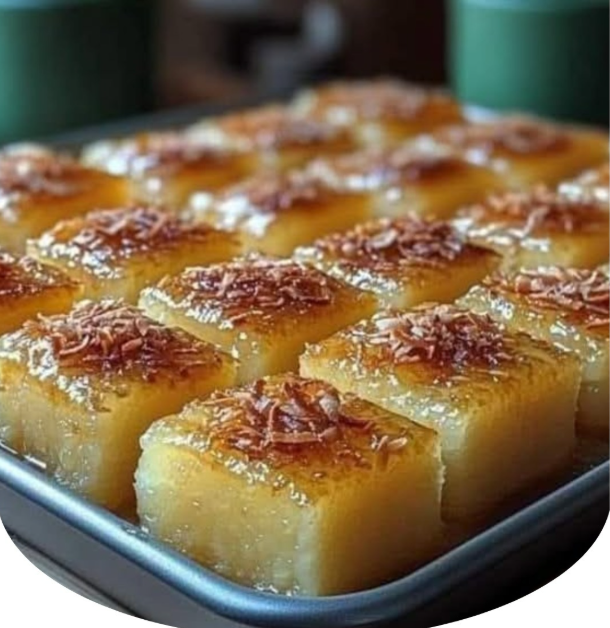Cassava cake with macapuno is one of the most beloved desserts in the Philippines. Its chewy, rich texture, coupled with the sweet, creamy custard topping and luscious macapuno layer, makes it a showstopper at any celebration or family gathering. This traditional Filipino dessert is deeply rooted in the culture and offers a unique combination of flavors that transport you straight to the tropics.
In this extensive article, we’ll explore every aspect of this iconic dish: from its cultural significance to the detailed ingredient breakdown, step-by-step preparation, expert tips, variations, and serving suggestions. By the end, you’ll be ready to make a cassava cake with macapuno that’s every bit as authentic and delicious as what you’d find in the Philippines—or even better!
Table of Contents
- Introduction to Cassava Cake and Macapuno
- The History and Cultural Significance of Cassava Cake
- Ingredients: What Makes Cassava Cake So Special
- Understanding Cassava: The Star Root
- What is Macapuno?
- Detailed Ingredients List
- Equipment Needed
- Step-by-Step Instructions for Making Cassava Cake with Macapuno
- The Custard Topping: How to Get the Perfect Glaze
- Baking and Broiling Tips
- Common Mistakes and How to Avoid Them
- Variations of Cassava Cake
- Serving Suggestions and Storage Tips
- Nutritional Information
- Frequently Asked Questions (FAQs)
- Final Thoughts and Why You Should Try Making Cassava Cake Today
1. Introduction to Cassava Cake and Macapuno
Cassava cake is a quintessential Filipino dessert made primarily from grated cassava, a starchy root vegetable. It’s often topped with a custard glaze and sometimes layered or adorned with macapuno, a sweet coconut sport string that adds a chewy, luscious texture.
This cake is loved for its unique chewy yet moist texture and its sweet, tropical flavors from coconut milk and condensed milk. It is naturally gluten-free, making it an excellent choice for those avoiding wheat or gluten.
2. The History and Cultural Significance of Cassava Cake
Cassava cake’s origins are intertwined with the introduction of cassava (also known as yuca) to the Philippines during the Spanish colonial period. Cassava itself is native to South America but became a staple in many tropical countries due to its adaptability and high yield.
In the Philippines, cassava became a vital crop and an affordable source of carbohydrates. Over time, cassava cake emerged as a popular dessert, especially in provinces where coconut trees abound. The addition of macapuno, a rare and prized variety of coconut with soft, jelly-like strings inside the fruit, elevated the dish to a festive status, often served during holidays, fiestas, and family celebrations.
3. Ingredients: What Makes Cassava Cake So Special
The magic of cassava cake lies in its combination of:
- Cassava: The root that provides the chewy texture.
- Coconut milk: Adds creaminess and a tropical aroma.
- Evaporated and condensed milk: Balance the richness and sweetness.
- Macapuno: Provides a sweet, chewy contrast that enhances the dessert’s texture and flavor.
- Custard topping: Adds a golden, slightly firm finish that melts in your mouth.
4. Understanding Cassava: The Star Root
Cassava, or manioc, is a starchy tuberous root native to South America but widely cultivated in tropical regions. It is highly versatile and used in various dishes worldwide.
Nutritional and Culinary Profile:
- High in carbohydrates, mainly starch.
- Gluten-free.
- When grated and baked with liquids and sugar, cassava transforms into a chewy, moist cake base.
For this recipe, grated cassava is best, whether fresh or frozen. Fresh cassava offers superior texture, but frozen grated cassava, once thawed, is a convenient alternative.
5. What is Macapuno?
Macapuno is a naturally occurring coconut variety characterized by its soft, jelly-like “sport strings” inside the fruit instead of regular coconut meat. These strings are sweet, chewy, and prized for desserts. Macapuno is commonly sold canned or jarred, preserved in syrup, and used as a topping or mix-in for cakes, ice cream, and other sweets.
6. Detailed Ingredients List
For the Cake Base:
- 4 cups (about 500g) grated cassava (fresh or thawed frozen)
- 1 can (13.5 oz) coconut milk
- 1 can (14 oz) sweetened condensed milk
- 3 eggs
- ½ cup (100g) granulated sugar
- ½ cup (120 ml) evaporated milk
- 1 tsp vanilla extract
- ¼ tsp salt
For the Macapuno Layer:
- 1 jar (12 oz) macapuno strings, drained
For the Custard Topping:
- 1 can (13.5 oz) coconut milk
- 3 egg yolks
- ¼ cup (50g) sugar
- 1 tbsp cornstarch (optional, for thicker glaze)
7. Equipment Needed
- Large mixing bowl
- Grater (if using fresh cassava)
- Measuring cups and spoons
- Whisk
- 9×13-inch baking pan (or similar size)
- Oven
- Saucepan (for custard)
- Spatula
- Fine sieve or strainer (optional for custard)
8. Step-by-Step Instructions for Making Cassava Cake with Macapuno
Step 1: Prepare the Cassava Cake Mixture
- In a large mixing bowl, combine grated cassava, coconut milk, sweetened condensed milk, evaporated milk, granulated sugar, eggs, vanilla extract, and salt.
- Mix thoroughly until all ingredients are well incorporated. The batter will be slightly runny but thick due to the grated cassava.
Step 2: Preheat Oven and Prepare Baking Pan
- Preheat your oven to 350°F (175°C).
- Grease your baking pan with butter or line it with parchment paper for easier removal.
Step 3: Layer the Cake and Macapuno
- Pour half of the cassava mixture into the pan and spread evenly.
- Evenly distribute the drained macapuno strings over the cassava layer.
- Pour the remaining cassava mixture over the macapuno layer, ensuring it’s fully covered.
Step 4: Bake the Cassava Cake Base
- Place the pan in the preheated oven. Bake for 45–55 minutes or until the edges start to turn golden and a toothpick inserted comes out clean or with minimal moist crumbs.
- Remove the pan from the oven and set aside to cool slightly.
Step 5: Prepare the Custard Topping
- In a saucepan, combine coconut milk, sugar, and egg yolks. Whisk gently until smooth.
- Optionally, dissolve cornstarch in a tablespoon of water and add it to the saucepan to thicken the custard.
- Cook over medium-low heat, stirring constantly, until the custard thickens enough to coat the back of a spoon (about 5-7 minutes). Do not let it boil, or the eggs may curdle.
- Remove from heat and let it cool slightly.
Step 6: Apply the Custard Topping and Broil
- Pour the custard topping evenly over the baked cassava cake.
- Return the pan to the oven and broil on high for 5-10 minutes, or until the custard topping turns golden brown and bubbly.
- Keep a close eye to avoid burning.
Step 7: Cool and Serve
- Allow the cake to cool completely before cutting. This helps the cake and custard to set properly for cleaner slices.
- Cut into squares or rectangles and serve.
9. The Custard Topping: How to Get the Perfect Glaze
The custard topping is essential for that signature shiny, golden finish. It adds richness and a silky texture to complement the chewy cake.
Tips for success:
- Use fresh eggs for a better custard texture.
- Whisk continuously while cooking to avoid lumps and curdling.
- Add cornstarch if you prefer a thicker glaze that holds better when slicing.
- Broil carefully and watch closely to avoid burning.
10. Baking and Broiling Tips
- Baking time varies depending on oven type; test with a toothpick at 45 minutes.
- Use an oven thermometer to ensure temperature accuracy.
- Broil at a safe distance to prevent burning the custard.
- Rotate the pan halfway during baking for even cooking.
11. Common Mistakes and How to Avoid Them
- Not draining macapuno properly: Excess syrup can make the cake soggy. Drain well.
- Overbaking: Causes dryness; check cake doneness early.
- Skipping reserved water: Sometimes adding a little liquid can help cake texture, but this recipe uses milk and eggs, so no added water is needed.
- Broiling too long: Custard can burn quickly, watch carefully.
12. Variations of Cassava Cake
- Cheese Cassava Cake: Sprinkle grated cheddar cheese over custard topping before broiling.
- Ube (Purple Yam) Cassava Cake: Add ube halaya (purple yam jam) to the batter for color and flavor.
- Peanut or Nut Topping: Add crushed peanuts or toasted coconut flakes for extra texture.
- Vegan Version: Substitute eggs with flaxseed or chia seeds and use coconut condensed milk alternatives.
13. Serving Suggestions and Storage Tips
- Serve warm or at room temperature.
- Pair with hot coffee or tropical fruit juices.
- Store leftovers in an airtight container in the refrigerator for up to 4 days.
- Reheat gently in the microwave or steam to restore moisture.
14. Nutritional Information (Approximate per serving)
- Calories: 350–400 kcal
- Fat: 15g (mostly from coconut milk and butter)
- Carbohydrates: 50g
- Protein: 5g
- Sugar: 25g
Note: Nutritional values vary based on exact ingredient brands and quantities.
15. Frequently Asked Questions (FAQs)
Can I use frozen grated cassava?
Yes! Thaw it fully and drain excess moisture if needed.
What if I can’t find macapuno?
Substitute with shredded young coconut meat or omit altogether.
Can I make this cake gluten-free?
Absolutely! Cassava is naturally gluten-free.
How do I prevent the cake from cracking?
Avoid rapid temperature changes and don’t overbake.
16. Final Thoughts and Why You Should Try Making Cassava Cake Today
Cassava cake with macapuno is more than just a dessert—it’s a cultural experience, a celebration of tropical flavors, and a testament to the versatility of humble ingredients. Making this cake at home allows you to appreciate Filipino culinary traditions while creating a dish that’s both comforting and exotic.
With this detailed guide, you’re equipped to make a delicious cassava cake that will impress your family and friends. So, grab your ingredients, preheat your oven, and bring a slice of the Philippines into your kitchen!




